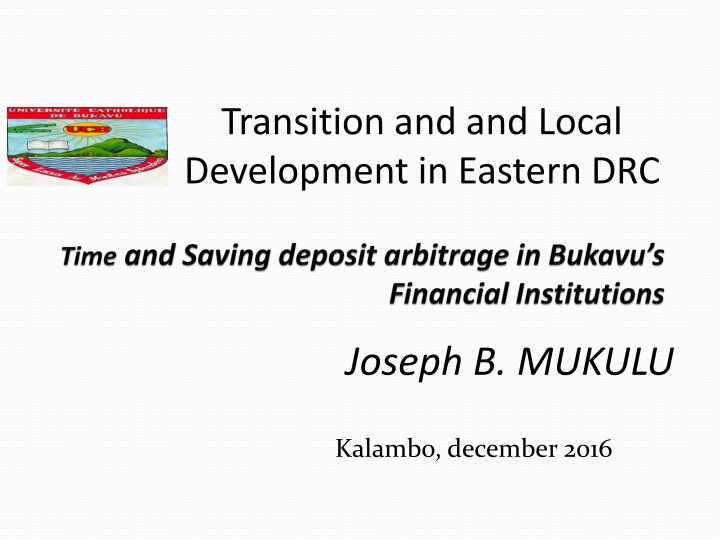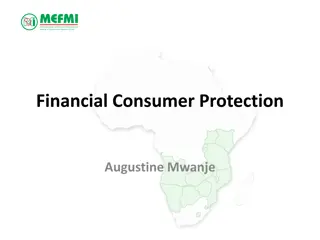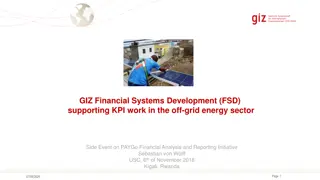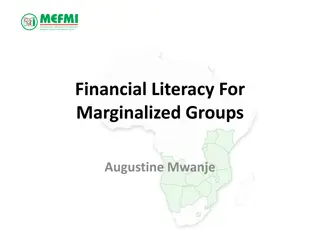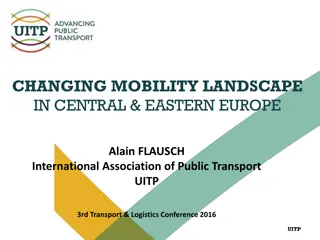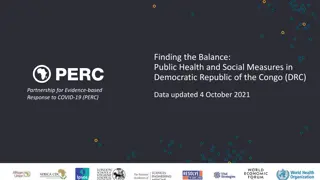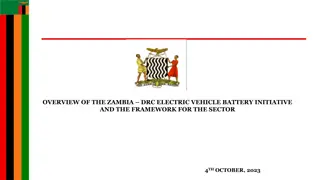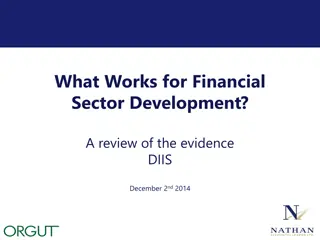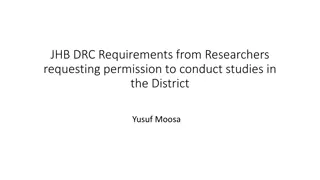Local Development Challenges in Eastern DRC Financial Sector
Developing countries like the DRC face challenges in their financial sectors, particularly in the mobilization of savings and provision of credit services. This study focuses on factors influencing savers' choices in South Kivu, shedding light on the importance of understanding local dynamics for fostering financial development.
Download Presentation

Please find below an Image/Link to download the presentation.
The content on the website is provided AS IS for your information and personal use only. It may not be sold, licensed, or shared on other websites without obtaining consent from the author.If you encounter any issues during the download, it is possible that the publisher has removed the file from their server.
You are allowed to download the files provided on this website for personal or commercial use, subject to the condition that they are used lawfully. All files are the property of their respective owners.
The content on the website is provided AS IS for your information and personal use only. It may not be sold, licensed, or shared on other websites without obtaining consent from the author.
E N D
Presentation Transcript
Transition and and Local Development in Eastern DRC Joseph B. MUKULU Kalambo, december 2016
Back ground In developing countries Finacial sector is more and more developed; the eastern part of DRC so (South Kivu) Several products have been suggested to savers (time deposit, saving deposit, insurance, etc.) Saving mobilization insufficient to cover liquidity and refinancing risks as Basel agreements suggests No well-adapted credit services supply
Problem Saving deposit is the most important financing source of financial institutions but is more and more reduce depiste Basel decisions In South Kivu, 10% of savings is in the sanving deposit (BCC, 2012) This essay intends to identify factors which Bukavu s savers focus on when making choice among different products offered
Litterature reviews Several theories but 3 importants schools : Classics and neoclassics (interest rate ; indidual preferency, inflation) Keynesian theorie (Residue, Luxury goods; Interest rate type of savings) Post-keynesian theories: Income), Modigliani (LCT active & passive) & Duesenberry (Emulate Theorie) Friedman (Permanent 2 greats periods :
and its done rationally? Beyond rationality hypothesis; choice not rational bcz of subjectivity (Kahneman & Tversky, (1979) & incomplete informations (limit) 1955) Modification and imperfection of savers attitudes bcz of shortcut mental & biases (Thaler, 1999; Deschamps et al. 2004 ; Barraud et al. 2008; Orl an, 2008; Bentayeb, 2013) People saves more or less than normally Limit rationality (Simon, Adequation betwen risk, rentability and disponibility (Hermann et al. 1978)
Methods &Technics 113947 bank s customers or IMF s members of 25 institutions (2014) Sample : 173 but 200 were concerned Data collected by questionnaires in 15 institutions and 167 questionnaires were fit (83,5% of fit responses) 12 variables were maintain: interest rate, age, income, dependance rate, sex, profession, civil s state, study level, social origin, rank, social s capital and financial experience
Methods &Technics 3 technics were used Descriptive statistics Comparating means : Levene, ANOVA & Welch, Tukey- Kramer & Games-Howell Econometric model 3 alternatives of dependant variable (saving deposit, time deposit and the both kinds of deposit) Multinomial Probit model after the IIA s test (Hausman & McFadden Test); Time deposit = basis alternative Interpretation done by marginal effect and analysis made by SPSS 20.0 and STATA 12
Findings: Descriptive and Means Comparison Bukavu s savers are young ( 35 years old); unmaried or maried ( 95%) & not diffrence men and women Most of savers live in Ibanda commune (64,1%) and their income bwn 100 & 500 Saver s average age (ANOVA &T-K) & income (Welch & G-H) statistically differents only btwn Time deposit & both s deposit savers
Findings: Econometrics Model Test of multicolinearity : VIF <3 No multicolinearity problem (VIF >10) IIA Test: not conclusive 7 explain choice (b) savings at Bukavu 6 common related to time deposit & both kinds of accounts (time deposit & saving deposit) Multionomial Probit These variables affect products choice differently
Econometrics; Table marginal effect Saving deposit Variables Marginal s effects Both kinds of deposits (Time & Saving) .0223027* -.0238388* .0105557* -.0455649*** -.1050468*** .0119058 .1364254*** -.021158* .1207253*** -.0170415** -.0544277** .0365755 Interest rate Age Income Dependance rate Sex Instruction s level Social s origin Kadutu Bagira -.009057 -.0789229 .1185748** .1499477*** .1030862 .1574834 -.0384984 .1327075*** Social s Capital Experience
Discussion & Conclusion About the saver s age, saving & the both kinds deposits become more and more attractiveness respectively at 43 & 47 years old LCH (Dean et al. 1989 ; Arrondel et al. 2011 ; Borgy et al. 2011; Modigliani et al. 1960; Modigliani, 1986) These results confirm theories & previews works
Thanks josephlegrand.jbm@gmail.com; bahati.mukulu@ucbukavu.ac.cd
